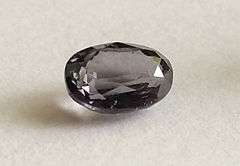Musgravite
| Musgravite | |
|---|---|
|
Musgravite from Sri Lanka, 0.59 ct | |
| General | |
| Category | Oxide minerals |
| Formula (repeating unit) | (Mg,Fe,Zn)2BeAl6O12 |
| Strunz classification | 04.FC.25 |
| Crystal system | Trigonal |
| Identification | |
| Color | Grey green to green |
| Fracture | Conchoidal |
| Mohs scale hardness | 8–8.5 |
| Luster | Vitreous |
| Diaphaneity | Transparent |
| Specific gravity | 3.62–3.68 |
| Optical properties | Uniaxial |
| Refractive index | nω = 1.739, nε = 1.735 |
| Birefringence | δ = 0.014 to 0.016 |
| References | [1][2] |
Musgravite or magnesiotaaffeite-6N’3S (chemical formula of Be(Mg, Fe, Zn)2Al6O12), is a rare oxide mineral. It is used as a gemstone. Its type locality is the Ernabella Mission, Musgrave Ranges, South Australia for which it was named.[2] It is a member of the taaffeite family of minerals.[2][1] Its hardness is 8 to 8.5 on the Mohs scale.[2]
References
This article is issued from Wikipedia - version of the 11/17/2016. The text is available under the Creative Commons Attribution/Share Alike but additional terms may apply for the media files.
